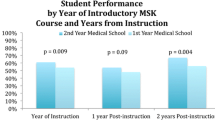Abstract
Background
We designed, implemented and assessed an interactive musculoskeletal teaching module for fourth-year medical students. Over a 2-week period, students followed a programme of alternating lectures, interactive tutorials, case discussions, clinical examination and ‘how to do’ sessions using patients and clinical models.
Methods
Over a 4-month period, 140 fourth-year medical students rotated for 2 weeks through a new interactive musculoskeletal teaching module in an elective orthopaedic hospital. To assess the impact of our module, a basic-competency examination in musculoskeletal medicine was developed and validated. Each student completed the examination on the first and last days of the module. We also assessed musculoskeletal basic knowledge in students from a different medical school, receiving a classic lecturing programme.
Results
In the pre-course assessment, only 20 % of students achieved an overall pass rate. The pass rate increased to 85 % in post-course examination. Students found particularly beneficial the interactive tutorial approach, with 48 % finding this to be the single most effective teaching method. When compared with students who completed a classic lecturing programme, students attending our interactive module scored higher in all aspects of musculoskeletal knowledge.
Significance
This study highlights the benefits and need for more interactive teaching of musculoskeletal medicine in medical schools.




Similar content being viewed by others
References
Yelin E, Herrndorf A, Trupin L, Sonneborn D (2001) A national study of medical care expenditures for musculoskeletal conditions: the impact of health insurance and managed care. Arthritis Rheum 44:1160–1169
Carr AJ, Harnden A (1997) Orthopaedics in primary care. Butterworth-Heinemann, Oxford
De Lorenzo RA, Mayer D, Geehr EC (1990) Analyzing clinical case distributions to improve an emergency medicine clerkship. Ann Emerg Med 19:746–751
Freedman KB, Bernstein J (1998) The adequacy of medical school education in musculoskeletal medicine. J Bone Joint Surg Am 80-A:1421–1427
Kahl LE (1987) Musculoskeletal problems in the family practice setting: guidelines for curriculum design. J Rheumatol 14:811–814
Marsland DW, Wood M, Mayo F (1976) Content of family practice. Part I. Rank order of diagnoses by frequency. Part II. Diagnoses by disease category and age/sex distribution. J Fam Pract 3:37–68
Mulhall KJ, Masterson E (2005) Relating undergraduate musculoskeletal medicine curricula to the needs of modern practice. Ir J Med Sci 174:46–51
Pinney SJ, Regan WD (2001) Educating medical students about musculoskeletal problems. Are community needs reflected in the curricula of Canadian medical schools? J Bone Joint Surg Am 83-A:1317–1320
Williams JR (2000) The teaching of trauma and orthopaedic surgery to the undergraduate in the United Kingdom. J Bone Joint Surg Br 82:627–628
Bernstein J, Alonso DR, DiCaprio M et al (2003) Curricular reform in musculoskeletal medicine: needs, opportunities, and solutions. Clin Orthop Relat Res 415:302–308
DiCaprio MR, Covey A, Bernstein J (2003) Curricular requirements for musculoskeletal medicine in American medical schools. J Bone Joint Surg Am 85-A:565–567
Craton N, Matheson GO (1993) Training and clinical competency in musculoskeletal medicine. Identifying the problem. Sports Med 15:328–337
Booth A, Wise DI (1990) General practice training in musculoskeletal disorders. Br J Gen Pract 40:390
Reznick RK, Brewer ML, Wesley RM, Stauffer ES (1987) Orthopaedic teaching: the practicing family doctor’s perspective. Orthop Rev 16:529–535
Editorial Guest (1998) The Bone and Joint Decade 2000–2010. Acta Orthop Scand 69:219–220
Reznick RK, MacRae H (2006) Teaching surgical skills—changes in the wind. N Engl J Med 355:2664–2669
Hill D, Stalley P, Pennington D et al (1997) Competency-based learning in traumatology. Am J Surg 173:136–140
Bilderback K, Eggerstedt J, Sadasivan KK, Seelig L, Wolf R, Barton S, McCall R, Chesson AL Jr, Marino AA (2008) Design and implementation of a system-based course in musculoskeletal medicine for medical students. J Bone Joint Surg Am 90(10):2292–2300
Day CS, Yu YR, Yeh AC, Newman LR, Arky R, Roberts DH (2009) Musculoskeletal preclinical medical school education: meeting an underserved need. J Bone Joint Surg Am 91(3):733–739
Freedman KB, Bernstein J (2002) Educational deficiencies in musculoskeletal medicine. J Bone Joint Surg Am 84:604–608
Matzkin E, Smith EL, Freccero D, Richardson AB (2005) Adequacy of education in musculoskeletal medicine. J Bone Joint Surg Am 87:310–314
Stockard AR, Allen TW (2006) Competence levels in musculoskeletal medicine: comparison of osteopathic and allopathic medical graduates. J Am Osteopath Assoc 106:350–355
Conflict of interest
All authors state that there is no conflict of interest in the submitted manuscript; there are no financial and personal relationships with other people or organisations that could inappropriately influence (bias) the submitted work.
Author information
Authors and Affiliations
Corresponding author
Rights and permissions
About this article
Cite this article
Vioreanu, M.H., O’Daly, B.J., Shelly, M.J. et al. Design, implementation and prospective evaluation of a new interactive musculoskeletal module for medical students in Ireland. Ir J Med Sci 182, 191–199 (2013). https://doi.org/10.1007/s11845-012-0855-0
Received:
Accepted:
Published:
Issue Date:
DOI: https://doi.org/10.1007/s11845-012-0855-0




